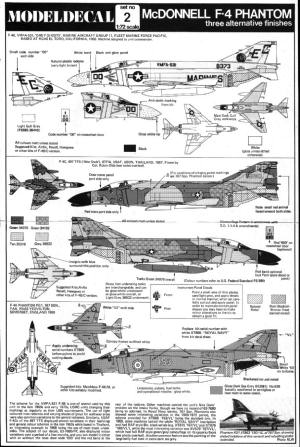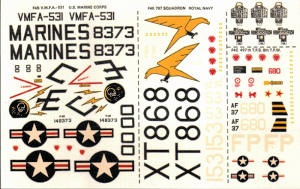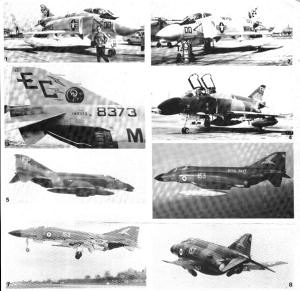 The Modeldecal range of
1/72 aircraft markings eventually extended to over 115 sheets. Whilst that's
nowhere near the hundreds (and hundreds) of releases of the other main decal
company of the same era in Microscale, it is a significant body of work. And
that was mostly the work of one Richard Ward, otherwise known as Dick Ward or
R.L. Ward. That's a name not only associated with decals but also a number of
books including 'Hunter squadrons of the RAF' as well as the Profile series from
Aircam.
The Modeldecal range of
1/72 aircraft markings eventually extended to over 115 sheets. Whilst that's
nowhere near the hundreds (and hundreds) of releases of the other main decal
company of the same era in Microscale, it is a significant body of work. And
that was mostly the work of one Richard Ward, otherwise known as Dick Ward or
R.L. Ward. That's a name not only associated with decals but also a number of
books including 'Hunter squadrons of the RAF' as well as the Profile series from
Aircam.
When Modeldecal were at their peak in the '80s and
early '90s it was often lamented that they only issued 1/72 sheets, it should be
remembered that their releases were mainly aimed at their home market in the UK
and western Europe, where 1/72 was the most popular scale and there were few
kits of post war (WWII that is) European aircraft in 1/48 or 1/32. With Dick
Ward regarded by many as THE expert on British markings it was no surprise that
Airfix engaged him for the decals in their series of modern 1/48 aircraft -
Tornado, Buccaneer and Jaguar as well as the reissue of their 1/24 Harrier and
several other kits they brought to market in the '90s. They weren't the only
ones with several of the Cottage kit producers such as Pegasus also using his
talents.
 That's
all part of the rich history of our hobby but what of the decals themselves. The
Editor has written of many of the qualities of these decal Sets, and Sets is
what they were marketed as, in his review of Set No.64. This review is of Set
No.2, which is for 3 F-4s. It is remarked on the instruction sheet that this Set
was originally issued in 1969 and reissued in 1972 and reissued again in 1981
with a revised instruction sheet
That's
all part of the rich history of our hobby but what of the decals themselves. The
Editor has written of many of the qualities of these decal Sets, and Sets is
what they were marketed as, in his review of Set No.64. This review is of Set
No.2, which is for 3 F-4s. It is remarked on the instruction sheet that this Set
was originally issued in 1969 and reissued in 1972 and reissued again in 1981
with a revised instruction sheet
The 3 subjects are:
F-4B 148373 of VMFA-531, US Marine
Corp, the 'Gray Ghosts' at El Toro, California in 1968. This is when this
aircraft was assigned to the unit commander and wears the '00' (double nuts)
number. Aircraft is in the Light Gull Grey upper and White lower scheme with a
light Brown nose radome. The unit's tail emblem differs slightly on either side
of the fin and this is catered for. All the main markings are on the sheet with
stencils to come from the chosen kit. 3 pics of the aircraft, including a
close-up of the tail markings, are included. Suggested kits are from Airfix,
Revell and Hasegawa. That refers to the original kits from those companies, any
of the more recent releases from Esci, Italeri, Fujimi or Hasegawa would be
suitable and more desirable.
 F-4C 63-7680 FP 680 of
the 497 TFS, 8 TFW, USAF at Ubon, Thailand in 1967. The aircraft is in the 2
Greens, Tan and Grey SEA scheme. This was one of the aircraft flown by Col.
Robin Olds and is marked as a double Mig killer with 2 red stars on the left
splitter plate. Only 1 of these is credited to Olds, a Mig 21 on May 4, 1967.
Again an image is provided of the aircraft and in the general notes it is stated
that in this pic the large centre line tank is painted green (34079) and the
under wing tanks are the same. A small number of stencils are included for this
aircraft.
F-4C 63-7680 FP 680 of
the 497 TFS, 8 TFW, USAF at Ubon, Thailand in 1967. The aircraft is in the 2
Greens, Tan and Grey SEA scheme. This was one of the aircraft flown by Col.
Robin Olds and is marked as a double Mig killer with 2 red stars on the left
splitter plate. Only 1 of these is credited to Olds, a Mig 21 on May 4, 1967.
Again an image is provided of the aircraft and in the general notes it is stated
that in this pic the large centre line tank is painted green (34079) and the
under wing tanks are the same. A small number of stencils are included for this
aircraft.
F-4K, FG.1 XT868 153/VL of 767 Sqn.
FAA Royal Navy, Yeovilton, England 1969. This aircraft is in the standard FAA
scheme of Extra Dark Sea Grey upper surfaces and White undersides. The squadron
markings are a large yellow bird with out-stretched claws. This adorns the tail.
The large Royal Navy title on the fuselage and the roundels are not provided and
it is suggested these be taken from the kit decals, in this case the Matchbox
kit is suggested. I think most would go for one of the Fujimi kits now. Several
useful images of this aircraft are provided as well as one of XV579 157/VL in
RAF style Green/Grey camouflage with large 157 on the fuselage and the yellow
bird on the tail. That would be something different in a collection of UK
Phantoms for sure.
3 sets of generic F-4 instrument
panels are also provided and whilst today's modeller may not use these they
would have been very appreciated at the time of this Sets original release.
Paints are given their FS 595or BS381C numbers where appropriate, so the
modeller can use his/her brand choice. The decals are well printed and in
register with strong colours and minimal carrier film. After some 27 years my
copy shows no signs of yellowing or degrading so anyone thinking about
purchasing any of the Modeldecal line today (they do come up on e-bay and at
swap meets etc) should have no worries as long as they've been stored correctly,
that is, away from light and in a dry environment.
Graham Mison
April 2008
If you would like your product reviewed fairly and quickly, please contact
me or see other details in the Note to
Contributors.
 The Modeldecal range of
1/72 aircraft markings eventually extended to over 115 sheets. Whilst that's
nowhere near the hundreds (and hundreds) of releases of the other main decal
company of the same era in Microscale, it is a significant body of work. And
that was mostly the work of one Richard Ward, otherwise known as Dick Ward or
R.L. Ward. That's a name not only associated with decals but also a number of
books including 'Hunter squadrons of the RAF' as well as the Profile series from
Aircam.
The Modeldecal range of
1/72 aircraft markings eventually extended to over 115 sheets. Whilst that's
nowhere near the hundreds (and hundreds) of releases of the other main decal
company of the same era in Microscale, it is a significant body of work. And
that was mostly the work of one Richard Ward, otherwise known as Dick Ward or
R.L. Ward. That's a name not only associated with decals but also a number of
books including 'Hunter squadrons of the RAF' as well as the Profile series from
Aircam.  That's
all part of the rich history of our hobby but what of the decals themselves. The
Editor has written of many of the qualities of these decal Sets, and Sets is
what they were marketed as, in his review of Set No.64. This review is of Set
No.2, which is for 3 F-4s. It is remarked on the instruction sheet that this Set
was originally issued in 1969 and reissued in 1972 and reissued again in 1981
with a revised instruction sheet
That's
all part of the rich history of our hobby but what of the decals themselves. The
Editor has written of many of the qualities of these decal Sets, and Sets is
what they were marketed as, in his review of Set No.64. This review is of Set
No.2, which is for 3 F-4s. It is remarked on the instruction sheet that this Set
was originally issued in 1969 and reissued in 1972 and reissued again in 1981
with a revised instruction sheet  F-4C 63-7680 FP 680 of
the 497 TFS, 8 TFW, USAF at Ubon, Thailand in 1967. The aircraft is in the 2
Greens, Tan and Grey SEA scheme. This was one of the aircraft flown by Col.
Robin Olds and is marked as a double Mig killer with 2 red stars on the left
splitter plate. Only 1 of these is credited to Olds, a Mig 21 on May 4, 1967.
Again an image is provided of the aircraft and in the general notes it is stated
that in this pic the large centre line tank is painted green (34079) and the
under wing tanks are the same. A small number of stencils are included for this
aircraft.
F-4C 63-7680 FP 680 of
the 497 TFS, 8 TFW, USAF at Ubon, Thailand in 1967. The aircraft is in the 2
Greens, Tan and Grey SEA scheme. This was one of the aircraft flown by Col.
Robin Olds and is marked as a double Mig killer with 2 red stars on the left
splitter plate. Only 1 of these is credited to Olds, a Mig 21 on May 4, 1967.
Again an image is provided of the aircraft and in the general notes it is stated
that in this pic the large centre line tank is painted green (34079) and the
under wing tanks are the same. A small number of stencils are included for this
aircraft.